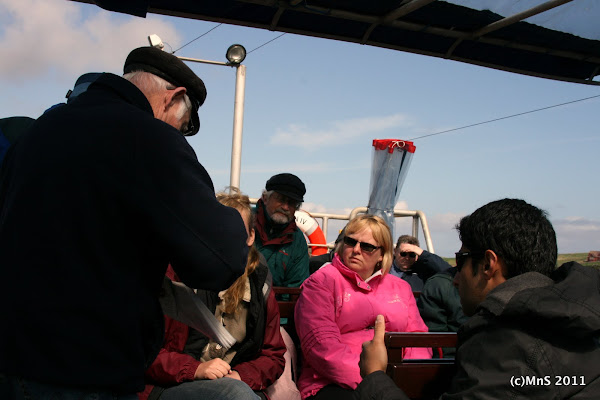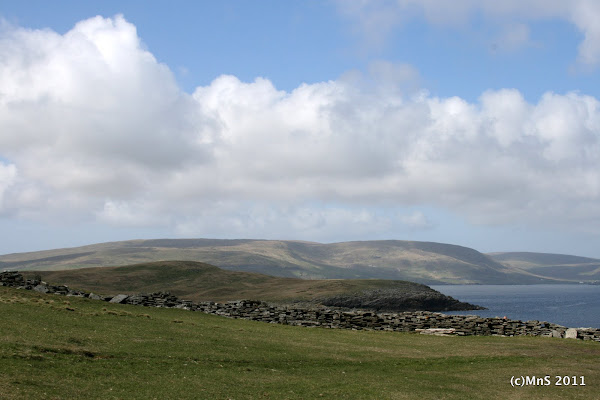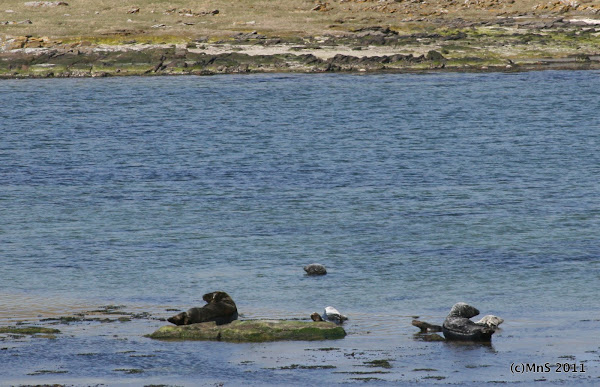An early flight to Shetlands saw us land in this beautiful cluster of islands with three entire days of exploring at our disposal. The sight of the mighty blue ocean encircling the cliffs, vast expanse of blue skies , sun splashed grassy hilltops ; We drive through all of them and our cab driver tells us,
The weather isn't this good all the time, you guys are lucky.. I love the Scottish accent. It is ever so cute.
We check in and explore the town a bit. We've read so much about this place and yet every step surpasses any expectations we might have had from hours of armchair travel. Its beautiful.
Our morning is to plan how we would make best use of the next three days. We are not lucky enough to get on the ferry to
Samburgh head, but the afternoon ferry to
Mousa is available. Thrilled to bits. The sounds of seagulls squeaking over food is a constant, as numerous as crows they seem to perfectly glide over the smooth blue skies wiping away any clouds that might have been in sight...
 |
| On the boat to Mousa.. |
Our little ferry leaves only in the afternoon. Our ride costs us 15£ per head. We would have 4 hours to walk the island. Lying off the east coast of
Shetlands , we ride about 30 minutes from
Lerwick before we can sight land. The island emerges into view, a brown line against the distant horizon . It is currently uninhabited we are told. But there was a time when this was a
Norse settlement. The island itself is not very big; about a mile and a half in length and a mile in breadth.
As we step off our boats we are given maps; reminiscent of those given out during treasure hunts :)..
There are 7 points neatly marked out. We begin and walk along with the group. In a while everyone meanders off into their own private spaces. Just like any other journey a tour of an island is always a very personal thing.
 |
| The world is my canvas.. |
We peek down from where we walk. The cliff is full of birds. Right below us cormorants hang their wings out to dry.
The Shetlands are home to millions of birds. The sky and water is alive with life.
 |
| Cormorants, sitting by the cliffs and hanging their wings out to dry.. |
 |
| Endless Blue.. |
The grass is soft. Our legs tire easily. Every step seems to sink into the soft ground beneath.
Its not very good for the legs, S comments. In the very ancient Scandinavian
'Old Norse' tongue,
Mousa would mean Moss island and this is probably why. The island is teeming with life. There are no trees as with most of
Shetlands. But grass abounds. We are so close to the poles we realize; Almost at the Earth's end.
 |
| A Fulmar sits on a rocky ledge.. |
The rocks are spotted with yellow patches. Inch closer and its algae we realize. They look more like a splash of the gorgeous afternoon sun drying up on the huge wet rocks. Unbelievably beautiful.
 |
| Walking down Mousa.. |
As we walk on, the marking on the map become less understandable. We try to make sense of the turns we seem to take. We walk upto what looks like a rocky wall. Some of the others who got there ahead of us seem to be looking out in silence. We read the sign which says the spot is perfect to view Seals and Otters. We stand there for a while. Couple of Fulmars swoop ahead. They seem to be flying low.
We probably are very close to their nesting grounds. We are right in the middle of what is rightly their home and they will do everything they have to to defend it. Walking a little way beyond the wall we see why. We guessed right on this ocassion. We see the wall has fulmars sitting along its length in different places. Their body language says 'Do not Disturb'..
 |
| The Iron age Broch in a distance |
We walk on and a huge stone like structure looms on the horizon. This is Mousa's most famous inhabitant; A 2000 year old iron-age structure -
'The Mousa Broch'. We walk upto this stone built castle and look up to see it towering 43 feet above us. We walk in. A comment on anything as old as the
Broch comes automatically prefixed with probably and so it goes that this was probably used in defense or maybe even as some sort of status symbol. Mentioned in old texts as a hideout for eloping lovers , there are 120 other such
Brochs through the Shetlands.
 |
| A closer look at the Broch.. |
Standing in a circular clearing , the walls tower over us. There are torch lights kept aside for those who want to explore. I am suddenly claustrophobic. We can hear signs of activity in these walls. This is where the smallest bird of the Shetlands, T
he Stormy Petrels come to nest. But to see them we have to visit by night as these tiny birds not much bigger than a sparrow are off to the feeding grounds by day. The Stormy Petrel , of which there are 10000 nesting pairs here in the islands, fly along the Arctic and look for Plankton on which they feed. The broch lays claim to being UK's biggest Bird Box!!
 |
| Inside the Broch.. |
We can climb to the very top, someone is already there before us so we wait our turn. But then we abandon the pursuit as the walls are too narrow.
 |
| Walking up.. |
We walk away looking back. The blue seas and the bluish sky makes for a beautiful setting. If there was a god he would have to be an artist, probably impressionist ;)
 |
| On the other side of the Broch.. |
We walk up a little higher. The grass gets thicker. Our senses perk up. Its amazing how even after millions of years of the human civilization living in cities we have not lost our instinct to survive. Our ears hear more clearly and our eyes catch sight of the slightest of movements. Suddenly two big brown birds emerge into view. They are sitting on the high ground. We did not know then, but we had come face to face with the
'Great Skua' or
'Bonxie' as it is more commonly called. They along with gulls and terns nest inland. Each pair could be guarding a nest with upto two eggs or chicks even and are known to dive bomb people who get too close. Everything about their aggressive body language tells us to run and in retrospect it was a little foolish to stop to take pictures. But in my defense I did capture the posturing male.
 |
| A pair of Great Skuas... |
We beat a hasty retreat and our map doesn't say much. We are lost we admit. We check how we are doing on time. We have a little over an hour to find our way back. Reconstructing scenarios of people lost on lonely islands I become a traveling companion's worst nightmare.
 |
| Evening glory.. |
We get to a point and realize we are inside the area where seals come to nest. In a distance we can see them. We stand quietly watching.
 |
| Seals in the wild.. |
The Shetlands are home to two kinds of seals -
'The Grey Seals' and
'Harbour Seals', told apart by the shape of their snouts
. What looks like an inland pond we discover later is one of the largest nesting places for seals. We can see a few in a distance
 |
| The grey seal |
I really need to zoom in. Its so beautiful, primeval even. There are no sounds except for an occasional bird calling out to another or screaming out its isolation to the skies.
The wind blows, the sun is getting hot against my bare skin, my feet are grass tired and my partner is anxious. Reluctantly we walk. We are not sure if we we are on the right track but we know its time to find out. We see others walking back to the boat in a distance. Suddenly hungry we split an energy bar and gulp down the last bit of water we have left.
 |
| Puffin in a distance.. |
We take the boat back. That night we sleep , almost dreamless. We discuss it the next day over a hot steaming cup of tea...
comments.. I have to smile! :)